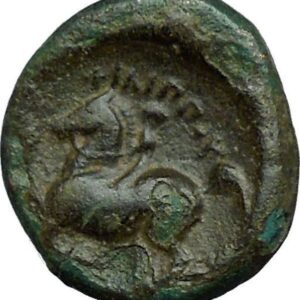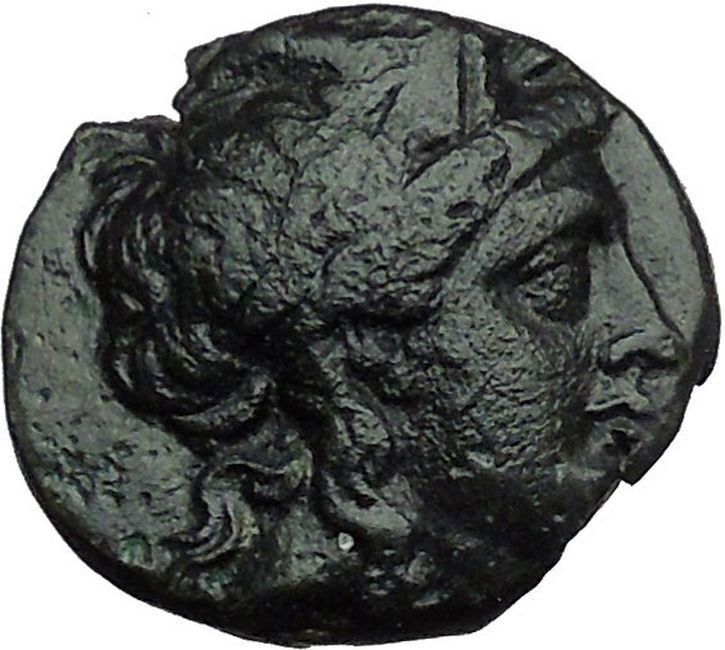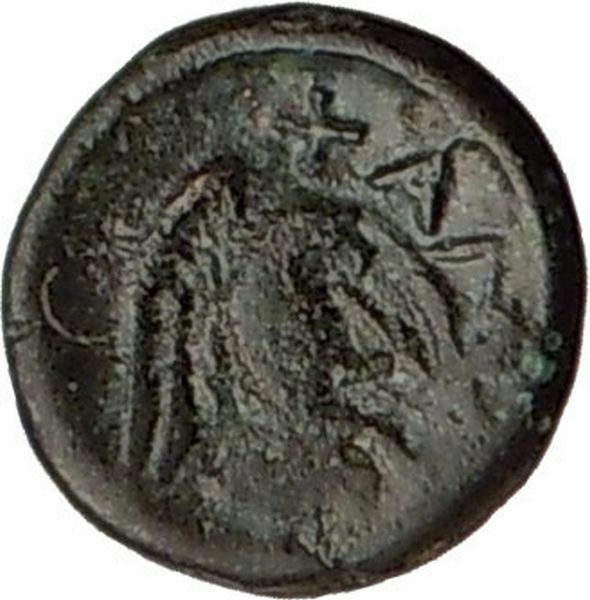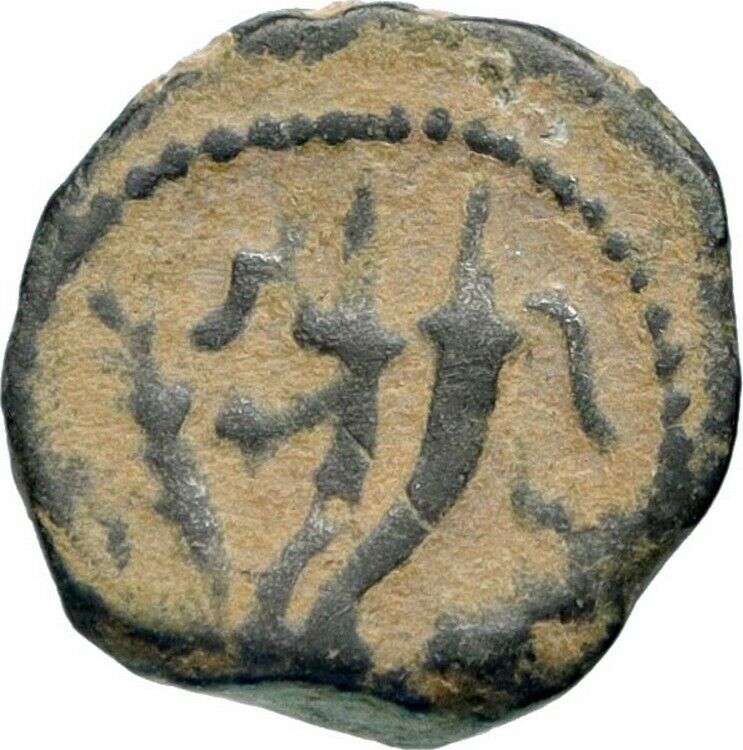|
Greek city of
Kyme in
Aeolis
Bronze 10mm (0.91 grams) Struck circa 350 B.C.
Reference: Sear 4186; B.M.C. 17.106,20
Eagle standing right, wings closed.
K – Y on either side of one-handled vase.
By far the most important of the Aiolian coastal cities, Kyme was situated
southwest of Myrina. For much of its history it was dominated by great powers – Athens, the Hellenistic Kingdoms and, finally, Rome.
You are bidding on the exact item pictured,
provided with a Certificate of Authenticity and Lifetime Guarantee of
Authenticity.
Cyme (or Kymi, also: Phriconis, modern
Namurt) was an
ancient Greek
city in
Aeolis
(Asia
Minor) close to the kingdom of
Lydia
. The
Aeolians
regarded Cyme as the largest and most important of their twelve cities, which
were located on the coastline of
Asia Minor
(modern day
Turkey
). As a
result of their direct access to the sea, unlike most non-landlocked settlements
of the ancient world, trade is believed to have prospered. In his Histories,
Herodotus
makes reference to Cyme (or Phriconis) as being one of the cities in which the
rebel Lydian governor Pactyes sought refuge, following his attempted rebellion
against the Persian King
Cyrus the Great
:
Pactyes, when he learnt that an army was already on his tracks and near,
took fright and fled to Cyme, and
Mazares
the Mede marched to
Sardis
with
a detachment of Cyrus’ troops. Finding Pactyes and his supporters and his
supporters gone, the first thing he did was to compel the Lydians to carry
out Cyrus’ orders — as a result of which they altered from that moment their
whole way of life; he then sent a demand to Cyme that Pactyes should be
surrendered, and the men of the town decided to consult the oracle at
Branchidae
as to whether they should obey…The messengers returned home
to report, and the citizens of Cyme were prepared in consequence to give up
the wanted man.
//
Location
Both the author of the ‘life of
Homer
‘ and
Strabo
the
ancient geographer, locate Cyme north of the Hermus river on the Asia Minor
coastline, modern day Namurt Limani

Map of Aegean c.200 BC showing the location of Kyme.
After crossing the
Hyllus
, the
distance from Larissa to Cyme was 70 stadia, and from Cyme to Myrina was 40
stadia. (Strabo: 622)
Archaeological finds such as coins give reference also to a river, believed
to be that of the Hyllus
.
Early
history
Little is known about the foundation of the city to supplement the
traditional founding legend. Settlers from mainland Greece (most likely
Euboea
)
migrated across the
Aegean Sea
during the Late Bronze Age as waves of Dorian-speaking invaders brought an end
to the once mighty
Mycenaean
civilisation some time around 1050 BC. During the Late Bronze Age
and early Greek Dark Ages the dialect of Cyme and the surrounding region of
Aeolis, like that of neighboring island Lesbos closely resembled the local
dialect of Thessalia and Boetia.
Culturally however the citizens of Cyme considered themselves of Ionian
descent. An
Ionic dialect
is believed to have been the local language and would have
given rise to the famous
Cumae alphabet
that is believed to have originated in or near Cyme.
Archaeologists believe Kyme was already inhabited by
Pelasgians
prior to the Euboean arrival:
Around 950 every tribe had settled down in its own territory. They
co-existed beside each other, but never formed a nation… they even almost
never felt as one nation. There would always be a strong contrast between
the different groups, especially between the
Ionians
and the Dorians. The
Ionians
arrived in Hellas around 1600 and mixed with the original inhabitants while
the Dorians
arrived 500 years later and enslaved them, without learning anything from
their culture. The
Dorians
valued their system of tribes and remained isolated as Sparta would show
later on, while the
Ionians
valued art, science and individualism which were the cornerstones of
Athens
.
The colony was founded during the Greek Dark Ages by settlers from Locris in
central Greece who began by reducing the Pelasgian citadel of Larisa near the
river Hermus
Cyme developed into a regional metropolis to some thirty other towns and
settlements in Aeolis. The Cymeans were later ridiculed as a people who had for
three hundred years lived on the coast and not once exacted harbor taxes on
ships making port. Hesiod’s father is said to have started his journey across
the Aegean from Cyme. The cities of southern Aeolis in the region surrounding
Cyme occupied a good belt of land with rough mountains in the background yet
Cyme like other colonies along the coast did not trade with the native
Anatolians further inland who had occupied Asia Minor for thousands of years.
Cyme consequently played no significant role in the history of western Asia
Minor prompting the historian Ephorus, himself a native of the city, to comment
repeatedly in his narrative of Greek history that while the events he wrote
about were taking place his fellow Cymeans had for centuries sat idly by and
kept the peace.
Politically, Cyme is assumed to have started as a settler democracy following
in the tradition of other established colonies in the region although Aristotle
concluded that by the 7th and 6th centuries BC the once great democracies in the
Greek world (including Cyme) evolved not from democracies to oligarchies as was
the natural custom but from democracies to tyrannies.
Cyme was an important settlement long before the prominent events of the
Greco-Persian wars. Evidence has pointed to Cyme establishing itself not as a
democracy but rather a monarchy under King Agamemnon of Cyme who supposedly
married his daughter to King Midas of Lydia
5th
Century BC
By the 5th century BC, Cyme was one of the 12 established Ionian colonies in
Aeolis.
Herodotus (4.138) mentions that one of the esteemed voters deciding whether or
not to support Militiades the Athenian in his plan to liberate the Ionian Coast
from Persian rule in (year BC) was Aristagoras of Cyme. Aristagorus campaigned
on the side of Histiaeus the Milesian with the tyrants Strattis of Chios, Aeaces
of Samos and Laodamas of Phocaea in opposing such an initiative arguing instead
that each tyrant along the Ionian Coast owed their position to Darius King of
Persia and that liberating their own cities would encourage democracy over
tyranny. Cyme eventually came under the control of the
Persian Empire
following the collapse of the
Lydian Kingdom
at the hands of Cyrus the Great.
Herodotus
is the principal source for this period in Greek history and has paid a great
deal of attention to events taking place in Ionia and Aeolis.
When Pactyes, the Lydian general sought refuge in Cyme from the
Persians
the citizens were between a rock and a hard place. As
Herodotus
records, they consulted the Greek god
Apollo
(supporting the claim that they were of Ionic not eastern culture), who said
after much confusion through an oracle that he should be handed over. However a
native of Cyme questioned Apollo’s word and went back to the oracle himself to
confirm if indeed Apollo
wanted the Cymians to surrender Pactyes. Not wanting to come to grief
over the surrender of Pactyes, nor wanting the ill-effects of a Persian siege
(confirms Cyme was a fortified city capable of self defence) they avoided
dealing with the Persians by simply sending him off to
Mytilene
on
the island of Lesbos
, not far from their city.
After the Persian naval defeat at Salamis, Xerxes moored the surviving ships
at Cyme. Before 480 BC, Cyme had been the principle naval base for the Royal
Fleet.
Later accounts of Cyme’s involvement in the
Ionian Revolt
which triggered the Persian Wars confirm their allegiance to
the Ionian Greek cause. During this time, Herodotus states that due to the size
of the Persian army,
Darius the Great
was able to launch a devastating three-pronged attack on
the Ionian cities. The third army which he sent north to take
Sardis
was
under the command of his son-in-law
Otanes
who
promptly captured Cyme and
Clazomenae
in the process. However later accounts reveal how Sandoces, the
supposed Ionian governor of Cyme helped draft a fleet of fifteen ships for
Xerxes I
great expedition against mainland Greece c. 480 BC. Cyme is also
believed to have been the port in which the Persian survivors of the
Battle of Salamis
wintered and lends considerable weight to the argument
that Cyme was not only well served by defensive walls, but enjoyed the benefits
of a large port capable of wintering and supplying a large wartime fleet. As a
result, Cyme, like most Ionian cities at the time was a maritime power and a
valuable asset to the Persian Empire.
Once Aristagoras
of
Miletus
roused the Ionians to rebel against
Darius
, Cyme
joined the insurrection. However, the revolts at Cyme were quelled once the city
was recovered by the
Persians
.
Sandoces, the governor of Cyme at the time of
Xerxes
, commanded fifteen ships in the Persian military expedition against
Greece (480 BC). Herodotus believes that Sandoces may have been a Greek.
After the
Battle of Salamis
, the remnants of Xerxes’s fleet wintered at Cyme.
Thucydides does not provide any significant mention of place is hardly more than
mentioned in the history of
Thucydides
.
Roman
and Byzantine eras
Polybius
records that Cyme obtained freedom from taxation following the defeat of
Antiochus III
, later being incorporated into
Roman
Asia province.
During the reign of
Tiberius
,
the city is believed to have suffered from a great earthquake, common in the
Aegean.
Other Roman sources such as
Pliny the Elder
mention Cyme as one of the cities of
Aeolia
which supports
Herodotus
‘
similar claim:
The above-mentioned, then, are the twelve towns of the Ionians. The
Aeolic cities are the following:- Cyme, called also Phriconis,
Larissa
,
Neonteichus,
Temnus
, Cilla
,
Notium
, Aegiroessa,
Pitane
,
Aegaeae,
Myrina
, and Gryneia. These are the eleven ancient cities of the
Aeolians
.
Originally, indeed, they had twelve cities upon the mainland, like the
Ionians
,
but the Ionians
deprived them of
Smyrna
, one
of the number. The soil of
Aeolis
is
better than that of
Ionia
, but
the climate is less agreeable.
Archaeological coinage exists from the Roman Imperial era from
Nero to
Gallienus
.
The river god Hermos, horse with their forefoot raised and victorious athletes
are typical symbols commonly found on period coinage minted at Cyme.
Later under the leadership of the
Eastern Roman Empire
, Cyme became a
bishop
‘s see.
Archaeology
Archaeologists first started taking an interest in the site in the middle of
the 19th century as the wealthy landowner D. Baltazzi and later S. Reinach began
excavation on the southern necropolis. In 1925, A. Salaç, working out of the
Bohemian Mission, uncovered many interesting finds, including a small temple to
Isis, a Roman
porticus and what is believed to be a ‘potter’s house’. Encouraged by their
successes, Turkish archaeologist E. Akurgal
began his own project in 1955 which uncovered an Orientalising ceramic on the
southern hill. Between 1979-1984, the Izmir Museum carried out similar
excavations at various locations around the site, uncovering further
inscriptions and structures on the southern hill.
Geophysical studies at Cyme in more recent years, have given archaeologists a
much greater knowledge of the site without being as intrusive. Geomagnetic
surveys of the terrain reveal additional structures beneath the soil, as yet
untouched by excavations.

Statue of a young woman; late Hellenistic, 1st century BC, Cyme (Namurt).
The northwest side of the southern hill was utilized as a residential
neighborhood during the entire existence of the city. Only a limited area of
the hill has been investigated. It has been verified that there were at
least five successive phases of building. 1. A long and straight wall going
from north to southeast represented the most ancient building phase. In the
wall there are visible traces of a threshold linking two rooms. There is
uncertainty as to the chronology of the wall, but what is sure is that is
was built before the end of the 5th century BC. 2. Two rooms (A and B), that
were part of a building dating back to the end of the 5th century BC, belong
to the second phase. The building appears to be complete on the northern
side, but could have also had other rooms on the southern side, where the
entrance to room A opened up. The western wall of room A, was constructed
with squared limestone blocks, and also acted as a terracing wall connecting
the strong natural difference on the side of the hill. At the foot of this
wall there was a cistern excavated in the rock that gathered water coming
from the roof of the house. The cistern was filled with debris and great
amounts of black and plain pottery dating back to the late Hellenistic Age.
3. Some walls that belonged to the Imperial Roman Period were constructed by
means of white mortar and bricks. During this phase a service room east of
room A, with a floor that was made of leveled rock, was built. In the area
of the cistern, by now filled, a new room decorated by wall paintings was
also built. 4. A large house occupied the area during the Late Roman Period.
The rooms were constructed using reused materials, but without the use of
mortar, and often enriched by polychrome mosaics. Access was gained by a
ramp placed at the edge of the southwestern part of the excavation. Still,
what needs to be clarified is the extent of the building, whose destruction
is placed between the end of the 6th century to the beginning of the 7th
century AD. 5. The final phase is represented by some superficial structures
found at the northern part of the excavation. There is a long wall going
from the northwest to the southeast and a ramp built with reused blocks,
with the same orientation as the wall. The wall and the ramp could be proof
that this area was utilized during the Byzantine Age.
Trivia
Cyme was the birthplace of the historian
Ephorus
; and
Hesiod
‘s
father, according to the poet (Op. et D. 636), sailed from Cyme to settle at
Ascra in Boeotia
;
which does not prove, as such compilers as
Stephanus
and
Suidas
suppose, that
Hesiod
was a
native of Cyme.
|










